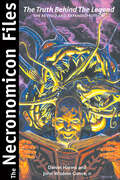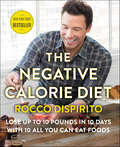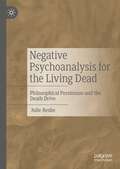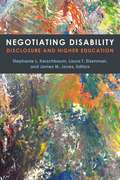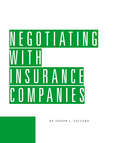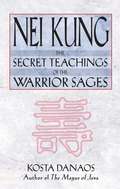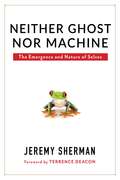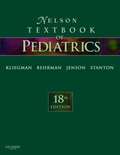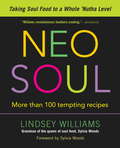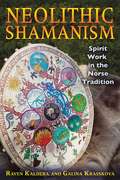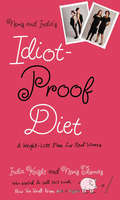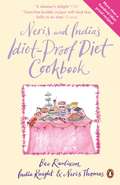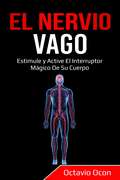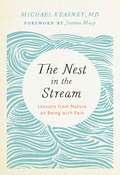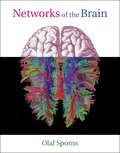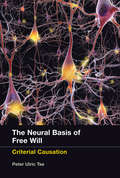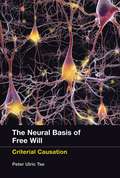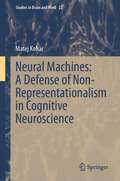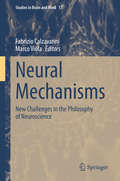- Table View
- List View
The Necronomicon Files: The Truth Behind The Legend
by Daniel Harms John Wisdom Gonce IIIOccult scholars explore how H. P. Lovecraft’s fictional book of magic became a cultural phenomenon and real-life legend in this revised and expanded volume.What if a book existed that revealed the answers to all of life’s mysteries? For those who believe in it, The Necronomicon is exactly that—an eighth-century occult text of immense power. In. fact, The Necronomicon is a creation of science fiction writer H. P. Lovecraft, who referred to the work in a number of stories and gave weight to its legend by inventing its own elaborate history.In The Necronomicon Files two occult authorities explore all aspects of The Necronomicon, from its first appearance in Lovecraft’s fiction to its ongoing pervasive appearance in cult and occult circles. The authors show how Lovecraft’s literary circle added to the book’s legend by referring to it in their own writing. As people became convinced of the book’s existence, references to it in literature and film continue to grow. This revised and expanded edition also examines the lengths people have undergone to find the Necronomicon, and the cottage industry that has arisen in response to the continuing demand for a book that does not exist. The Necronomicon Files illuminates the transformations of a modern myth, exposing a literary hoax while celebrating the romance of Necronomicon lore.
Needles: A Memoir of growing up with diabetes
by Andie DominickThe author tells of growing up with her sister who has diabetes and then later her own journey with diabetes.
The Negative Calorie Diet: Lose Up to 10 Pounds in 10 Days with 10 All You Can Eat Foods
by Rocco DiSpiritoThe #1 New York Times bestselling author, chef, and healthy living expert Rocco DiSpirito returns with a revolutionary whole foods-based diet plan and cookbook featuring more than seventy-five delicious recipes and 100 color photographs.In The Negative Calorie Diet, Rocco DiSpirito shares how simple it is to eat wholesome, delicious foods that naturally support weight loss. He calls these foods “negative calorie foods”—foods that help you to burn body fat, lose weight, and boost your metabolism. These whole foods are packed with fiber, so not only do you tend to eat smaller portions of them naturally, but you also stay fuller, longer. These nutritious superfoods offer the essential vitamins and minerals the body needs to keep your metabolism running efficiently. Some even offer what is known as a “thermogenic effect”—effectively boosting your metabolism to increase the rate at which your body burns energy. And you can eat as much of them as you want!Rocco begins with a ten-day cleanse designed to kick-start weight loss and detox the body, preparing it to reap the benefits of a nutrient-rich, whole foods diet. Next comes the twenty-day meal plan, with step-by-step guidance to help you achieve maximum results. To make it easy, Rocco gives you more than seventy-five recipes for meals, snacks, smoothies, and desserts that use his Top 10 Negative Calorie Foods: almonds, apples, berries, celery, citrus fruits, cruciferous vegetables (such as cauliflower and Brussels sprouts), cucumbers, leafy greens (including Swiss chard, spinach, and kale), mushrooms, and nightshade vegetables, including peppers, tomatoes, eggplant, and more.Complete with grocery shopping lists, troubleshooting FAQs, a guide to dining out, and advice for adapting the plan for kids and families as well as vegetarian, gluten-free, and low-sugar lifestyles, The Negative Calorie Diet helps you build healthy habits to lose weight and achieve better health for a lifetime.
Negative Psychoanalysis for the Living Dead: Philosophical Pessimism and the Death Drive
by Julie ResheThis book offers a radical alternative to the positive orientation of popular psychology. This positive orientation has been criticized numerous times. However, there has yet to be a coherent alternative proposed. We all know today that life hurts and that there is no ultimate remedy to this pain. The positive approach feels to us as dishonest and irrelevant. We require a new, more negative, perspective and practice, one that is honest and does not pretend to offer an escape from the agonies of the world. This book offers in three main chapters a ‘depressive realist’ perspective that explores the structural role of negativity and tragedy in relation to the individual psyche, society, and nature. It explores the possibility of ‘negative psychoanalysis’ which takes into account the tragedy of human existence instead of adopting escapist positions.
Negotiating Disability: Disclosure and Higher Education
by Stephanie L Kerschbaum Laura T Eisenman James M JonesDisability is not always central to claims about diversity and inclusion in higher education, but should be. This collection reveals the pervasiveness of disability issues and considerations within many higher education populations and settings, from classrooms to physical environments to policy impacts on students, faculty, administrators, and staff. While disclosing one’s disability and identifying shared experiences can engender moments of solidarity, the situation is always complicated by the intersecting factors of race and ethnicity, gender, sexuality, and class. With disability disclosure as a central point of departure, this collection of essays builds on scholarship that highlights the deeply rhetorical nature of disclosure and embodied movement, emphasizing disability disclosure as a complex calculus in which degrees of perceptibility are dependent on contexts, types of interactions that are unfolding, interlocutors’ long- and short-term goals, disabilities, and disability experiences, and many other contingencies.
Negotiating With Insurance Companies
by Joseph VaccaroNegotiating With Insurance Companies Many plaintiffs' attorneys waste negotiating time by presenting information to adjusters in ways that do not resonate with them. Negotiating With Insurance Companies will teach you how to increase the size of your clients' settlements by using language, arguments and evidence that move adjusters and claims personnel. Packed with proven, practical advice culled from author Joseph L. Vaccaro's 40 years of insurance claims handling experience, this book brings you an insider's perspective on how to establish coverage, how to influence the carrier's reserves on your claim, and how to gain a tactical advantage in negotiations, mediation and litigation. Discover strategies for handling issues related to: * Personal auto claims * Commercial auto/truck claims * General liability claims * Big damages, bad liability cases * Own occupation disability income claims * Non-ERISA health insurance claims * Homeowners and commercial property losses * Bad faith
Nei Kung: The Secret Teachings of the Warrior Sages
by Kosta DanaosExplains the science behind the practice of nei kung, the elemental nature of yin and yang energy--the two components of ch'i, and how learning to control the yang energy in our ch'i can result in the release of dynamic energy. • Establishes the existence and understanding of nei kung in the practices of many of the world's ancient cultures.• Includes a step-by-step guide to the meditation that forms the basis of the practice of nei kung.• By Kosta Danaos, author of The Magus of Java and apprentice to an immortal of the Mo-Pai tradition.In 1994 Kosta Danaos was accepted as a student by John Chang, a Chinese-Javanese Taoist in the Mo-Pai tradition and a master of nei kung, the practice of harnessing and controlling our body's bioenergy, or ch'i. Nei Kung: The Secret Teachings of the Warrior Sages describes the practice of nei kung and how learning to control our ch'i can result in the release of dynamic energy that can be used for healing, pyrogenesis, telekinesis, levitation, telepathy, and more. Danaos suggests that both components of ch'i--yin and yang energy--are fundamental to the earth and to life and were recognized and used in many of the world's ancient cultures. Though we have forgotten how to access them, these components are in fact elemental parts of us. The author explains that we first must open our minds to the fact that the power of ch'i is real. Next, in learning to control our ch'i as a whole, we must learn to channel our yang energy in productive ways--a potential we all possess. To help readers understand their capacity to connect with this inner elemental power, the author offers a fascinating blend of teachings that include sound scientific theories explaining much of the "magic" of nei kung. He also offers historical, linguistic, artistic, and literary proof of the presence and understanding of nei kung throughout the ages and a step-by-step introduction to several types of simple meditation--fundamental to directing one's ch'i. With his engaging storytelling and disarming humor, his physics-based explanations for seemingly mystical phenomena, and his reassurances that he's really no different from the rest of us, Kosta Danaos shows us that once we remember our capacity to harness our yang energy, we can change ourselves and our world.
Neither Ghost nor Machine: The Emergence and Nature of Selves
by Jeremy ShermanIf the universe is aimless, how do selves and aims emerge? Why do living beings have aims when inanimate things do not? Current science encourages us to reject the ghost-in-the-machine explanation—that something called spirit, soul, mind, or will was somehow breathed into matter—and instead accept that selves are just matter, in aimless mechanistic motion like everything else. But what about life’s many emergent qualities, the multifarious purposes that shape actual physical behavior not just in human lives, but in all of life? Even the simplest life forms have adaptive functions, traits that accomplish goals or ends. How can we explain the nature and origin of selves and aims without resorting to supernatural forces or explaining them away as nothing but cause-and-effect mechanisms?In Neither Ghost nor Machine, Jeremy Sherman explains the emergence of selves and aims in an aimless universe. He distills for a general audience the theory developed by renowned neuroscientist Terrence Deacon, which extends the breakthrough constraint-based insight that inspired evolutionary, information, and self-organization theory. Emergent dynamics theory provides a testable hypothesis for how mattering arose from matter, function from physics, and means-to-ends behavior from cause-and-effect dynamics. It offers a physics of purpose, demonstrating that there is a strictly physical explanation for the emergence and nature of selves and aims, one that shows our existence in an otherwise inanimate universe is not absurd. Neither Ghost nor Machine bridges the gap between the hard and soft sciences, suggesting fresh and exciting solutions to philosophical mysteries that have perplexed humanity for millennia, from free will to causality to morality.
Nelson Textbook of Pediatrics (18th Edition)
by Robert M. Kliegman Richard E. Behrman Hal B. Jenson Bonita F. StantonThis new and 18th edition attempts to provide the essential information that practitioners, house staff, medical students, and other care providers involved in pediatric health care need to understand to effectively address the enormous range of biologic, psychologic, and social problems that our children and youth may face. Topics covered include genetics, endocrinology, etiology, epidemiology, pathology, pathophysiology, treatment, and prognosis.
Neo Soul: Taking Soul Food to a Whole 'Nutha Leve
by Lindsey WilliamsMore than one hundred taste-tempting soul-food recipes. <P><P> From the grandson of Harlem's queen of soul food, Sylvia Woods, comes a new take on soul food-down-home cooking that tastes as good as the food you grew up with. Lindsey Williams knows soul food. He was raised in the kitchen of his grandmother's restaurant, Sylvia's, where he mastered the art of soul-food cooking. But being around all of that good food took its toll. When he tipped the scales at four hundred pounds, he knew he had to make some serious changes. <P> That's when he lost more than half his body weight and began his own brand of healthy soul-food cooking that's loved by the clients of his catering business. Now, with Neo Soul, we can all enjoy some guilt-free soul food. <P> Neo Soul features more than one hundred of Williams's delectable recipes, including Grandma's Roasted Turkey, Lenzo's Trout Stuffed with Collard Greens, Okra Gumbo, Neo Sweet Potato Pie, and Blueberry Buckle. They're all so good, you'll never miss the fat.
Neolithic Shamanism: Spirit Work in the Norse Tradition
by Galina Krasskova Raven KalderaA step-by-step guide to working with the spirits of ancient northern Europe • Explains how to build relationships with Earth, Sun, Moon, Plants, Animals, Water, Fire, Craft, Air, and the Ancestors through 83 practical exercises • Explores the role of altered states in spirit work • Outlines the ancient cultural rules and taboos to avoid spiritual debt or offense We are all surrounded by spirits. Many people feel called to work with them, but few know where to begin. Enjoined by the gods and spirits to fulfill this need, Raven Kaldera and Galina Krasskova have reconstructed the indigenous spiritual traditions of northern Europe and Scandinavia extinguished more than one thousand years ago by the spread of Christianity. Arising from basic survival needs, these practical traditions are fundamentally tied to the elements found in the harsh world of the ancient North. Beginning with the skills tied to the Earth element, necessary for grounding prior to the more demanding aspects of the practice--working with Sun, Moon, Plants, Animals, Water, Fire, Craft, and Air--the authors explain, step by step, how to build relationships with each elemental spirit and the Ancestors. Offering 83 practical exercises, from cleansing with the Moon or borrowing the legs of Reindeer to making sacred space with Mugwort or creating an ancestor altar, they also explore building spirit relationships through altered states. Emphasizing the proper management of your spirit relationships to avoid spiritual debt or offense, the authors outline the ancient cultural rules and taboos that circumscribe these practices, essential knowledge for successful and fruitful spirit alliances. Detailing the beginning set of skills needed to work with the spirits of this ancient world, this comprehensive workbook offers a unique ancestral spiritual outlet for those of northern European descent as well as an accessible guide for anyone trying to fulfill their shamanic callings.
Neonatal Hematology
by Robert D. Christensen Pedro A. de Alarcón Eric J. WernerWritten by practising physicians specializing in pediatric hematology, neonatology, immunology, pediatric infectious disease and transfusion medicine, this is a practical guide to the pathogenesis, recognition and management of hematologic problems in the neonate. The focus is on clinical issues encountered by pediatric specialists, and there are chapters devoted to disorders of leukocytes, platelets, procoagulant and anticoagulant proteins, and disorders of red blood cells. Neonatal transfusion, malignant disorders in the newborn, neonatal hemoglobinopathy screening, harvesting and storage of umbilical cord stem cells are also covered, and practical approaches to diagnosis and treatment given.
Neonatal Neural Rescue: A Clinical Guide
by Alistair J. Gunn Denis V. Azzopardi A. David Edwards Joseph J. VolpeWorldwide more than one million babies die annually from perinatal asphyxia and its associated complications such as neonatal encephalopathy - one of the major causes of cerebral palsy and cognitive deficiencies in children aside from prematurity. Cooling the head - or the entire body - minimizes neuronal death, enabling the neonatal brain to be 'rescued' thus greatly improving developmental outcomes. Hypothermic neural rescue therapy has revolutionized the treatment of this condition and is a major recent achievement in neonatal medicine. This landmark book provides a brief scientific underpinning of hypothermic neural rescue therapy and lays out the evidence base for good practice. Internationally recognized authorities give practical advice, drawn from personal experience, on how to deliver hypothermia in the neonatal intensive care unit. A valuable addition to any neonatal unit, this is essential reading for neonatologists, neonatal nurses and paediatric neurologists.
Neptune Princess
by Ingrid TomeyPoppy broke her leg and is sure the strange lady next door put a curse on her. She wants to enter the Neptune Carnival. Obtaining the goodwill of her neighbor may lift the curse.
Neris and India's Idiot-Proof Diet: A Weight-Loss Plan for Real Women
by India Knight Neris ThomasThis book tells you how two friends did it, and how you can do it too. It's not a diet devised by some bossy string bean who has never been more than 7 pounds overweight, nor by a fat middle-aged doctor, but a real, long-term, workable diet for real people. A modified and therefore bearable low-carb, high-protein way of eating, the diet really works and includes meal plans, recipes, advice on clothes, make-up and hair at every stage from fat to thin. It doesn't include impossible exercise routines or disgusting things to eat. Above all, it gets to the bottom of why we overeat--and shows you how to stop. There's never been a diet book like it--for women, by women, with jokes and useful tips, and advice that is truly simple to follow. What other diet book tells you to pour yourself a large drink at the end of the day, because you've earned it?
Neris and India's Idiot-Proof Diet Cookbook
by Bee Rawlinson India Knight Neris ThomasIn Neris and India's Idiot-Proof Diet Cookbook India Knight and Neris Thomas enlist the help of Bee Rawlinson to create over a hundred low-carb recipes to help you get 'from pig to twig'.Low-carb cooking: a lot of meat with a side order of cream, right? Wrong. How about onion bhajias, sesame stir-fried duck and fabulously retro Black Forest Trifle for pudding? (Yes! Pudding!)Neris & India's Idiot-Proof Diet Cookbook is the least diety diet cookbook you've ever seen. Over a hundred quick-and-easy recipes (including some that need just five ingredients) cover every occasion. Each recipe fits perfectly into the Idiot-Proof Diet and will not only inspire and delight you, but - best of all - will make you shrink like you wouldn't believe.'The "Nigella of low-carb" . . . recipes you'll want to gorge on, whether you're following their low-carb plan or not' Scotland on Sunday'A practical and easy to follow collection of idiot-proof recipes that will inspire you to keep on track with your diet. You'll find recipes for breakfasts, snacks, soups, main meals, treats and desserts. Treat yourself' Easyfood'An easy-to-follow low-carb diet that doesn't mean eating meat three times a day' Woman & HomeIndia Knight is the author of four novels: My Life on a Plate, Don't You Want Me, Comfort and Joy and Mutton. Her non-fiction books include The Shops, the bestselling diet book Neris and India's Idiot-Proof Diet, the accompanying bestselling cookbook Neris and India's Idiot-Proof Diet Cookbook and The Thrift Book. India is a columnist for the Sunday Times and lives in London with her three children.Follow India on Twitter @indiaknight or on her blog at http://indiaknight.tumblr.com. Neris Thomas is a film producer and artist, she lives in London and is married with one daughter. Bee Rawlinson is a mother of four from Devon who came to Neris and India's attention through her delicious recipes on the Pig2Twig forum, the Diet's website.
El Nervio Vago: Estimule y Active el Interruptor Mágico de su Cuerpo
by Octavio Ocon¿Sabía usted que su cuerpo tiene un interruptor mágico? ¡Y que podría ser la clave de su salud! Estoy hablando del nervio vago, y realmente es mágico. ¡Conecta su cerebro con casi todos los órganos principales de su cuerpo! Además, es la fuente de energía para el sistema nervioso parasimpático, ¡Ese es el sistema que actúa como su propia píldora de relajación! Y es vital para su buena salud. De hecho, estimular el nervio vago puede ayudar con los siguientes problemas de salud: Estrés Preocupación constante Trastornos autoinmunes Enfermedad de Crohn Hipertensión Desórdenes gastrointestinales Este interruptor mágico puede ayudar con muchos otros problemas también. Este libro explicará la historia y los beneficios de activar este nervio extremadamente importante de una manera muy fácil de entender. Cubre cada uno de los siguientes temas: ¿Por qué es importante el nervio vago? Los estudios científicos que prueban que la estimulación del nervio vago funciona. ¿Dónde está el nervio vago en su cuerpo y cómo funciona? ¿Cómo puede activar este interruptor mágico en cualquier momento que lo necesite? ¿Cómo evaluar el estado del nervio vago? Un plan de activación del nervio vago que puede seguir fácilmente para maximizar los beneficios para la salud. Activar su nervio vago es como tener su propio entrenador personal de relajación que lo lleva a todas partes. ¡Estimularlo lo ayudará a relajarse incluso ante los peores factores estresantes! No solo lo ayudará a relajarse, sino que también lo ayudará a crear y a mantener una buena salud, y la mejor parte es que no es difícil activar este nervio. Si está listo para activar este interruptor mágico para mejorar su salud, ¡no hay mejor momento que este instante para aprender estas sencillas técnicas!
The Nest in the Stream: Lessons From Nature On Being With Pain
by Michael KearneyA concise and inspirational book for anyone dealing with chronic or acute pain by a long time palliative care doctor who is greatly inspired by Native American wisdom and the natural world. This book is a celebration of impermanence and what it means to be awake, alive, and connected to the world.The Nest in the Stream is an encouraging and inspiring book for the times we live in. Michael Kearney, a physician whose day job is alleviating the pain and suffering of others, shows that how we live with our pain matters hugely, as it affects our quality of living and our capacity to find healing for ourselves, for others, and for our world. Drawing on engaged Buddhism, the indigenous wisdom of Native American and Celtic spirituality, and the powerful teachings he gained by observing nature, Kearney presents a new model for resilience and self-care. Traditional models of self-care emphasize the importance of professional boundaries to protect us from stress, and time out to rest and recover. The Nest in the Stream offers a way of being with pain that is infused with mindfulness, openness, compassion, and deep nature connection that encourages us to act for the freedom and welfare of all. It will appeal to those whose everyday occupation involves dealing with pain, such as healthcare workers, environmental activists, or those working on the front lines of trauma, but it will also be of interest to everyone who longs to live in our wounded world with an open heart.
Nettoyage de Côlon Pour Perdre du Poids: meilleure santé, plus d'énergie et détoxification
by Kenneth BrownNettoyage de côlon pour perdre du poids : meilleure santé, plus d'énergie et détoxification De Kenneth Brown Présente des secrets professionnels utilisés pour se sentir en meilleure santé ! Souhaitez-vous éliminer l'inconfort, l'inflammation et la douleur ? Environ 80% de notre système immunitaire se trouve dans nos intestins, de nombreux maux d'aujourd'hui sont le résultat d'une mauvaise santé intestinale. Le nettoyage de votre côlon contribuera également à perdre du poids, à réduire les inflammations et à renforcer votre système immunitaire, vos niveaux d'énergie, votre concentration et à améliorer votre bien-être ! Vous vous sentirez mieux que jamais ! Grâce aux décennies de stratégies testées, cet ebook vous montrera le moyen le plus rapide et le plus efficace de nettoyer vos intestins ! Vous apprendrez comment augmenter votre bien-être en quelques semaines. Vous voulez savoir comment des personnes ayant pris beaucoup de poids, souffrant de maladies chroniques, de troubles de concentration et de douleurs ont pu augmenter leur bien-être naturel et éradiqué leurs maux ? Vous aussi, vous pouvez y parvenir, en suivant les conseils indiqués dans ce livre et vous pourrez enfin vous sentir mieux et être plus heureux.
Networks of the Brain
by Olaf SpornsOver the last decade, the study of complex networks has expanded across diverse scientific fields. Increasingly, science is concerned with the structure, behavior, and evolution of complex systems ranging from cells to ecosystems. Modern network approaches are beginning to reveal fundamental principles of brain architecture and function, and in Networks of the Brain, Olaf Sporns describes how the integrative nature of brain function can be illuminated from a complex network perspective. Highlighting the many emerging points of contact between neuroscience and network science, the book serves to introduce network theory to neuroscientists and neuroscience to those working on theoretical network models. Brain networks span the microscale of individual cells and synapses and the macroscale of cognitive systems and embodied cognition. Sporns emphasizes how networks connect levels of organization in the brain and how they link structure to function. In order to keep the book accessible and focused on the relevance to neuroscience of network approaches, he offers an informal and nonmathematical treatment of the subject. After describing the basic concepts of network theory and the fundamentals of brain connectivity, Sporns discusses how network approaches can reveal principles of brain architecture. He describes new links between network anatomy and function and investigates how networks shape complex brain dynamics and enable adaptive neural computation. The book documents the rapid pace of discovery and innovation while tracing the historical roots of the field. The study of brain connectivity has already opened new avenues of study in neuroscience. Networks of the Brain offers a synthesis of the sciences of complex networks and the brain that will be an essential foundation for future research.
The Neural Basis of Free Will: Criterial Causation
by Peter Ulric TseA neuroscientific perspective on the mind–body problem that focuses on how the brain actually accomplishes mental causation. The issues of mental causation, consciousness, and free will have vexed philosophers since Plato. In this book, Peter Tse examines these unresolved issues from a neuroscientific perspective. In contrast with philosophers who use logic rather than data to argue whether mental causation or consciousness can exist given unproven first assumptions, Tse proposes that we instead listen to what neurons have to say. Tse draws on exciting recent neuroscientific data concerning how informational causation is realized in physical causation at the level of NMDA receptors, synapses, dendrites, neurons, and neuronal circuits. He argues that a particular kind of strong free will and “downward” mental causation are realized in rapid synaptic plasticity. Such informational causation cannot change the physical basis of information realized in the present, but it can change the physical basis of information that may be realized in the immediate future. This gets around the standard argument against free will centered on the impossibility of self-causation. Tse explores the ways that mental causation and qualia might be realized in this kind of neuronal and associated information-processing architecture, and considers the psychological and philosophical implications of having such an architecture realized in our brains.
The Neural Basis of Free Will
by Peter Ulric TseThe issues of mental causation, consciousness, and free will have vexed philosophers since Plato. In this book, Peter Tse examines these unresolved issues from a neuroscientific perspective. In contrast with philosophers who use logic rather than data to argue whether mental causation or consciousness can exist given unproven first assumptions, Tse proposes that we instead listen to what neurons have to say. Because the brain must already embody a solution to the mind--body problem, why not focus on how the brain actually realizes mental causation? Tse draws on exciting recent neuroscientific data concerning how informational causation is realized in physical causation at the level of NMDA receptors, synapses, dendrites, neurons, and neuronal circuits. He argues that a particular kind of strong free will and "downward" mental causation are realized in rapid synaptic plasticity. Recent neurophysiological breakthroughs reveal that neurons function as criterial assessors of their inputs, which then change the criteria that will make other neurons fire in the future. Such informational causation cannot change the physical basis of information realized in the present, but it can change the physical basis of information that may be realized in the immediate future. This gets around the standard argument against free will centered on the impossibility of self-causation. Tse explores the ways that mental causation and qualia might be realized in this kind of neuronal and associated information-processing architecture, and considers the psychological and philosophical implications of having such an architecture realized in our brains.
Neural Machines: A Defense of Non-Representationalism in Cognitive Neuroscience (Studies in Brain and Mind #22)
by Matej KohárIn this book, Matej Kohar demonstrates how the new mechanistic account of explanation can be used to support a non-representationalist view of explanations in cognitive neuroscience, and therefore can bring new conceptual tools to the non-representationalist arsenal. Kohar focuses on the explanatory relevance of representational content in constitutive mechanistic explanations typical in cognitive neuroscience. The work significantly contributes to two areas of literature: 1) the debate between representationalism and non-representationalism, and 2) the literature on mechanistic explanation.Kohar begins with an introduction to the mechanistic theory of explanation, focusing on the analysis of mechanistic constitution as the basis of explanatory relevance in constitutive mechanistic explanation. He argues that any viable analysis of representational contents implies that content is not constitutively relevant to cognitive phenomena. The author also addresses objections against his argument and concludes with an examination of the consequences of his account for both traditional cognitive neuroscience and non-representationalist alternatives. This book is of interest to readers in philosophy of mind, cognitive science and neuroscience.
Neural Mechanisms: New Challenges in the Philosophy of Neuroscience (Studies in Brain and Mind #17)
by Fabrizio Calzavarini Marco ViolaThis volume brings together new papers advancing contemporary debates in foundational, conceptual, and methodological issues in cognitive neuroscience. The different perspectives presented in each chapter have previously been discussed between the authors, as the volume builds on the experience of Neural Mechanisms (NM) Online – webinar series on the philosophy of neuroscience organized by the editors of this volume. The contributed chapters pertain to five core areas in current philosophy of neuroscience. It surveys the novel forms of explanation (and prediction) developed in cognitive neuroscience, and looks at new concepts, methods and techniques used in the field. The book also highlights the metaphysical challenges raised by recent neuroscience and demonstrates the relation between neuroscience and mechanistic philosophy. Finally, the book dives into the issue of neural computations and representations. Assembling contributions from leading philosophers of neuroscience, this work draws upon the expertise of both established scholars and promising early career researchers.
